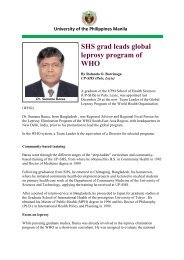NIH 2013 Program - University of the Philippines Manila
NIH 2013 Program - University of the Philippines Manila
NIH 2013 Program - University of the Philippines Manila
You also want an ePaper? Increase the reach of your titles
YUMPU automatically turns print PDFs into web optimized ePapers that Google loves.
4.3 Normal lung sound enhancement and characterization for automatic<br />
identification <strong>of</strong> lung pathologies<br />
(1) Department <strong>of</strong> Computer Technology, De La Salle <strong>University</strong><br />
(2) Philippine General Hospital, <strong>University</strong> <strong>of</strong> <strong>the</strong> <strong>Philippines</strong> <strong>Manila</strong><br />
Cadwallader C Chua (1), Kevin Lloyd D Cocuaco (1), Macario O Cordel II (1), Joel P Ilao (1),<br />
Alexis Jamie R Lao (1), Eldridge Sherwin S Tan (1), Adrian Paul J Rabe (2)<br />
Respiratory sounds are considered as non-invasive measurement <strong>of</strong> airway condition. Using a<br />
stethoscope, physicians can determine abnormalities by observing <strong>the</strong> patterns in lung sounds;<br />
this method is called auscultation. However, in a typical environment, auscultation is performed in<br />
rooms susceptible to different sounds such as vocal sound, ventilation machines, and ambient<br />
noise, which may impede <strong>the</strong> subjective evaluation <strong>of</strong> patterns heard from <strong>the</strong> lung sounds.<br />
This work presented a simple signal enhancement scheme for normal lung sounds in order to<br />
successfully extract <strong>the</strong> key signal patterns or features. Results showed that <strong>the</strong> enhanced signal<br />
had features (bandwidth, peak frequency, and center frequency) in <strong>the</strong> 300 to 700 Hz range while<br />
<strong>the</strong> raw and ‘denoised’ signals had features below 300 Hz. Listening test showed improved score<br />
in enhanced signals over <strong>the</strong> raw and ‘denoised’ signals with an average score <strong>of</strong> 1.3 (out <strong>of</strong> 3) as<br />
compared with 1.03 in raw and 0.82 in ‘denoised’ signals.<br />
5.1 Economics <strong>of</strong> health for productivity: role <strong>of</strong> economic evaluation in policy<br />
Department <strong>of</strong> Clinical Epidemiology, College <strong>of</strong> Medicine, <strong>University</strong> <strong>of</strong> <strong>the</strong> <strong>Philippines</strong> <strong>Manila</strong><br />
Carlo Irwin A Panelo<br />
Department <strong>of</strong> Clinical Epidemiology, College <strong>of</strong> Medicine, <strong>University</strong> <strong>of</strong> <strong>the</strong> <strong>Philippines</strong> <strong>Manila</strong><br />
Policy makers, service providers, and even families make use <strong>of</strong> economic tools to choose health<br />
care interventions, given <strong>the</strong> scarce resources. These tools range from <strong>the</strong> fairly sophisticated to<br />
<strong>the</strong> simple, intuitive or back <strong>of</strong> <strong>the</strong> envelope calculations.<br />
This presentation focuses on <strong>the</strong> application <strong>of</strong> economic tools for healthcare decision-making by<br />
governments or large insurance systems. Examples will be provided on how <strong>the</strong>se economic<br />
evaluation tools are applied to arrive at specific health care policy decisions and <strong>the</strong>ir impacts on<br />
health outcomes. These specific examples will also allude to <strong>the</strong> papers that will be presented as<br />
part <strong>of</strong> this panel. The role <strong>of</strong> economic evaluation will also be contextualized in <strong>the</strong> light <strong>of</strong> o<strong>the</strong>r<br />
considerations and bases that influence decision-making.<br />
SCIENCE AND HEALTH FOR SOCIAL AND ECONOMIC DEVELOPMENT 33




